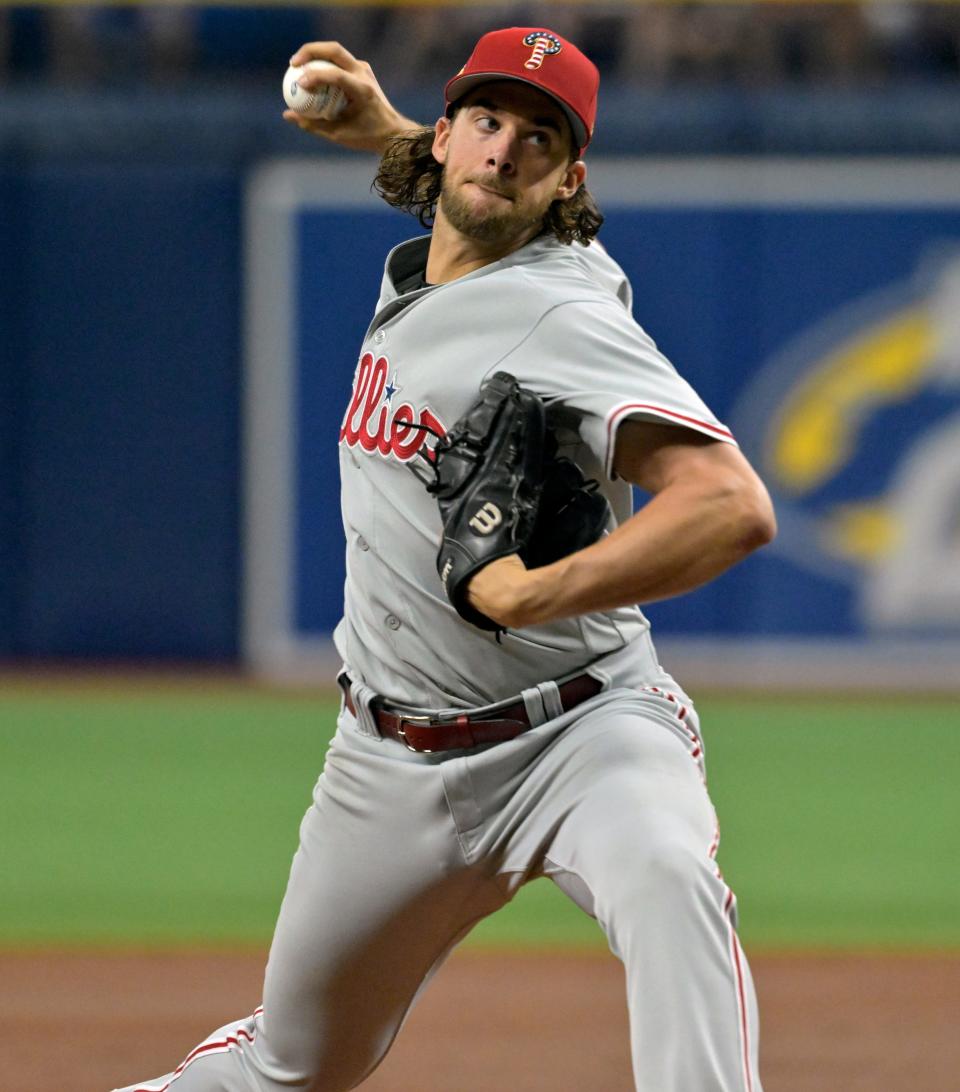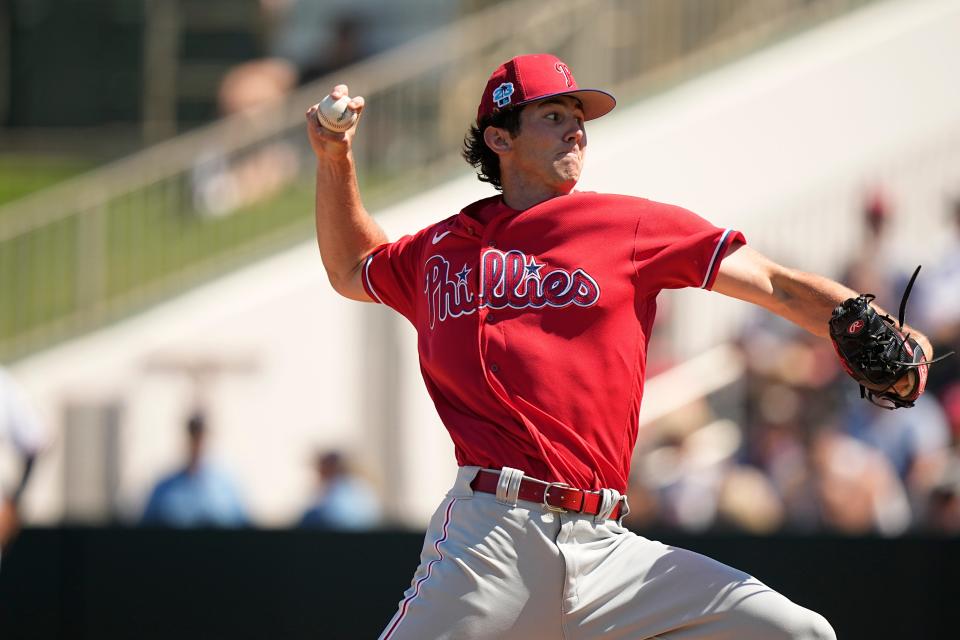How Phillies can trade Aaron Nola by MLB deadline and still reach World Series − this year
By all metrics, the Phillies are right where they need to be heading into the All-Star break.
They've turned around a slow start and put themselves in contention for a wildcard spot, just as they did last year when they ended up losing in Game 6 of the World Series.
And yet, there are issues, especially offensively. The Phillies (46-39) are ranked 18th in homers and 20th in runs. And they trail the Atlanta Braves by 11 games in the NL East after Wednesday's games.
So the Phillies face a conundrum heading into the final weeks before the Aug. 1 MLB trade deadline, specifically whether or not they should trade Aaron Nola.
Sure, Nola can be the Phillies' best pitcher, like he was Tuesday against Tampa Bay when he threw 7⅓ shutout innings and tied his career high with 12 strikeouts in the Phillies' 3-1 win. But he also has a 4.30 ERA this season, well above his career mark of 3.66.
What's more, Nola has a career record of 11-16 with a 4.26 ERA in the month of September. The winning percentage is the worst of his career, and the ERA is second worst to his June ERA of 4.37.
And oh, Nola can leave as a free agent after the season.

Why the Phillies should keep Nola
Nola gives the Phillies something no other pitcher on the team gives them: dependability. He has made at least 27 starts and pitched at least 168 innings in every season from 2017 through last season, the lone exception being the COVID-19 season of 2020.
Nola is on pace to do both again this season. That's vital after the Phillies spent much of the early season with a bullpen game in place of a fifth starter, not to mention injuries that severely tested their pitching depth.
Last season, Zack Wheeler missed a month from Aug. 20 until Sept. 21. Ranger Suarez has already missed a month this season. The Phillies have still yet to see 20-year-old phenom Andrew Painter, who was projected to be the fifth starter this season. Painter has been sidelined since suffering an elbow strain in spring training. And there's no timetable on when he can pitch in a game this season.
GO GET GOLDY: For pitching-rich Phillies, why trading for this star hitter could make all the difference
NOLA TOUGH: Nola beats former teammate Eflin as the Phillies beat AL-leading Rays 3-1 for 10th straight road win
In fact, one could make a case for the Phillies standing pat entirely at the trade deadline. Cristopher Sanchez has seemingly taken the fifth starter spot. Suarez posted a 1.08 ERA in June, and Taijuan Walker had an ERA of 0.84 over a span of five starts before allowing four runs in seven innings in the Phillies' 8-4 win over the Rays on Wednesday.
And there's the strong bullpen, led by closer Craig Kimbrel, who was named the National League's Reliever of the Month in June.
Offensively, standing pat would mean counting on Bryce Harper to find his power stroke. He has just three homers in 200 at-bats since returning from elbow surgery last November. He hasn't homered in his last 33 games.
Phillies manager Rob Thomson has said Harper could start playing first base sometime this month. That would make Kyle Schwarber a designated hitter instead of a leaky left fielder.
And when Harper isn't playing first base, the Phillies can use Darick Hall there after he missed 2½ months with a broken hand.
The Phillies would also be counting on Trea Turner approaching his yearly averages of 20-plus homers and 20-plus steals; All-Star Nick Castellanos continuing his robust hitting; and Bryson Stott, Alec Bohm and Brandon Marsh continuing their breakout seasons.

Why the Phillies should trade Nola
Painter is the key here.
If Painter can make it to the major leagues in August, the Phillies would still have a deep starting pitching staff with Wheeler, Suarez, Walker and Sanchez ahead of him. But that's a big if with Painter and the unproven Sanchez.
If the Phillies do go hard after a hitter, such as St. Louis' Paul Goldschmidt, they might have to include one of their two other top pitching prospects in Matt Abel or Griff McGarry.
In that case, it could make sense to trade Nola in order to get back a young player who's major-league-ready, or close to it.
There are several playoff-caliber teams who would love to have Nola's consistency down the stretch. That could include every team in the AL East besides the Rays, and especially the Baltimore Orioles who have a plethora of young players with a suspect veteran pitching staff.
The Phillies have done something like this before. In December 2009, they traded for Roy Halladay, giving up four prospects. On the very same day, they traded star pitcher Cliff Lee to the Seattle Mariners and got back three prospects.
Lee had gone 4-0 with a 1.56 ERA in the postseason just two months earlier. He was the winning pitcher in the Phillies' only two wins over the Yankees in the World Series.
"We could not keep the cupboard bare," then-Phillies GM Ruben Amaro said when the trades were made. "Is it risky? Yes, because you're moving a lot of talent."
It almost worked.
The Phillies had the best record in the National League in 2010 and Halladay won the Cy Young Award. But the Phillies lost to the Giants in the NLCS. The following year, the Phillies got Lee back as a free agent, then set the franchise record for wins with 102. But they lost to the Cardinals in the NLDS.
The problem was that the young players the Phillies got back in the Lee trade − pitcher Phillippe Aumont, outfielder Tyson Gillies and reliever J.C. Ramirez − never panned out. And when Halladay, Lee, Chase Utley, Jimmy Rollins and Ryan Howard, among others, started aging or breaking down, the Phillies couldn't replace them.
The Phillies didn't make the postseason again until last season.
So yes, the Phillies would have to find the right young player or players if they trade Nola. And that would fall on team president Dave Dombrowski and his staff.
Remember, the Phillies have a payroll of about $250 million, and they're paying the luxury tax for the second year in a row. Adding a veteran hitter will make the lineup better − and more expensive − while costing the Phillies at least one top prospect.
Trading Nola could bring a prospect back who can help this season while providing a chance for Painter to supplement a team with high-priced veterans like Harper, Turner, Schwarber, Castellanos, J.T. Realmuto and Wheeler.
It's a tough trick to pull off. But to win a World Series, the Phillies might have to.
Contact Martin Frank at mfrank@delawareonline.com. Follow on Twitter @Mfranknfl.
This article originally appeared on Delaware News Journal: How Phillies can trade Aaron Nola by MLB deadline, reach World Series
